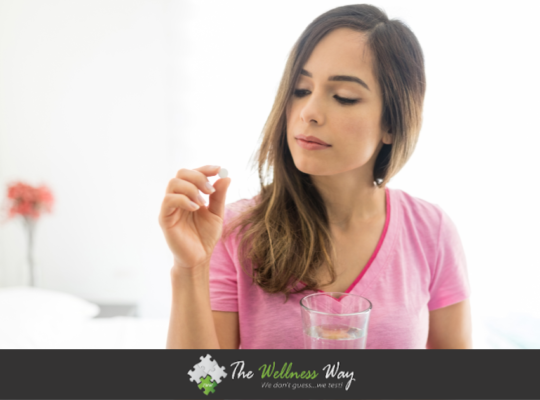
May 17th, 2020|Articles|
Only 2% of American adults regularly get the daily recommendation of potassium. Yes, it’s common not to get enough nutrients but 98% not getting enough potassium is a lot. And I was one of them for a long time! I was getting more than most people but not as much as I should be. Not many people are told about how important it is to get enough potassium and what this vital nutrient does. That’s leaving many Americans severely deficient in this mineral.
What is Potassium?
Potassium is the third most abundant mineral in the human body and is a critical part of many biological processes. It’s also an important electrolyte. Electrolytes help with electrical processes in the body such as nerve function, muscle contractions and fluid balance.
Every cell in your body, including brain and muscle cells, has something that is called a sodium potassium exchange pump that exchanges different electrolytes to create electrical activity. Sodium and potassium move in and out of the cells. This gives us energy and helps with brain activity. This impacts processes throughout your body and is why having good levels of sodium and potassium is so critical. While many people get plenty of sodium unfortunately, it’s not usually good salt, and they don’t get enough potassium.
Potassium has been shown to help:
- Stimulate Neural Activity
- Stabilize Blood Sugar
- Reduce Muscle Disorders
- Prevent Cramps
- Enhance Bone Health
- Regulate Neural Function
- Stabilize Blood Pressure
- Strengthen Muscles
- Boost Metabolism
- Reduce Anxiety and Stress
- Improve Heart Health
- Maintain Water Balance
How Much Potassium Do You Need?
The daily recommended amount of potassium for an adult is 4,700 mg. Now recommended daily amounts are what I think of as the bare minimum of what you need. To put that in perspective let’s talk about that fruit everyone recommends you eat when you get a leg cramp – the banana. How much potassium is in a banana? 422 mg of potassium are in a banana. You need to eat almost a dozen bananas to get your daily recommended amounts of potassium. Now there are a lot of sources of potassium and you want to eat a variety of vegetables. Depending on what types you eat, you need to eat between 5-12 cups of vegetables.
Your body doesn’t store potassium, so you need to eat potassium daily to get enough. How many of you are eating enough vegetables? If you’re not, you’re not alone. Only 1 in 10 Americans get the recommended amount of fruits and vegetables every day, let alone ones with enough potassium.
What Are Signs of Potassium Deficiency?
Because potassium is important for so many biological processes there are a number of signs of potassium deficiency. Here are some of the indicators to look for.
- Weakness and fatigue
- Digestive problems (constipation)
- Heart palpitations
- Tingling and numbness
- Mood changes
- Brain fog or slow thought
- Muscle cramps, aches spasms (especially fatigue going up stairs)
What Can Improve My Potassium Levels?
Avoid Sugar
Sugar impacts your potassium levels negatively. Sugar competes and depletes your potassium and B1. So, even all those healthy sugars can be bad for your potassium levels. That means even the organic sugar or sugar in that banana. It’s good for your potassium levels and there are so many benefits to giving up sugar.
Reduce Stress
You will dump a lot of potassium when you are under high levels of stress. That’s why you puff up when you are under a lot of stress because the sodium causes you to puff up when your body is losing potassium. I can never stress enough how important it is for health to reduce your stress!
Eat Potassium-rich Foods

Not all of the potassium-rich foods taste good. Beet greens are horrible and swiss chard is not that great. You can spice them up and sauté them up to make them tolerable. Not good – just tolerable. I don’t like all the foods I eat but I eat them because I like feeling good. I recommend not going overboard on fruits, white beans and other foods that are high in potassium but also can impact your insulin levels. You also want to watch for added sugars and other ingredients in your coconut water. Foods with less of an insulin response are better for getting potassium. You will find good amounts of potassium in clams, acorn squash, spinach and mushrooms. Below are my top 6 favorite foods that are really packed with potassium.
Best Potassium-rich foods:
- Beet Greens 1100-1300 mg
- White Beans 950-1100 mg
- Avocado 750-950 mg
- Swiss Chard 700-900 mg
- Salmon 600-700 mg
- Coconut water 500-600 mg
Supplement to Get Enough Potassium
It can be hard to find a good supplement because the medical community fears potassium supplementation. It can be dangerous for those with kidney disease or taking certain medications. Talk with a proficient provider to find out how much potassium would be right for you. It is hard to find a supplement with a good amount of potassium that is high quality so check out this potassium supplement from The Wellness Way.
Take Steps to Get Enough Potassium
Not many people know what potassium does, let alone know they are deficient in it. Don’t be one of the 98% of Americans who are deficient in potassium. Sufficient potassium can lower your risk of heart disease, stroke and fatty liver disease. It helps your body function optimally and it’s worth eating vegetables for!
Written by Dr. Patrick Flynn







